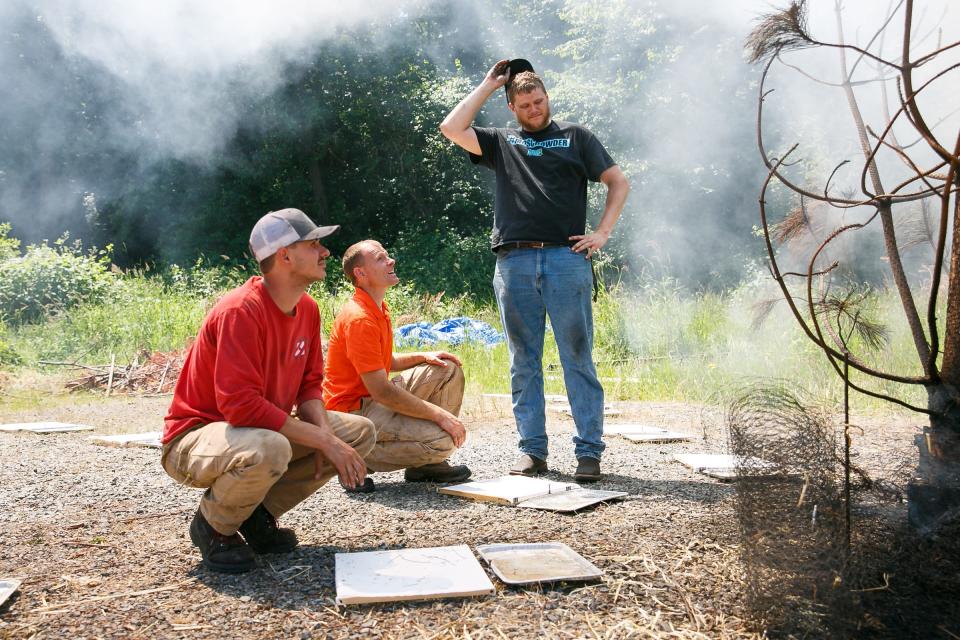Research offers insights into how to predict wildfire behavior, protect homes
David Blunck has spent years studying how wildfires spread.
But his academic research turned personal in September 2020, he said, when a wildfire neared his parents’ home in Canby.
Blunck, an associate professor of mechanical engineering at Oregon State University, knew the danger wasn’t from a wall of flames engulfing the home. Instead, it came from firebrands, windblown embers that can travel a mile or more, sparking new fires.
“It was just really eye-opening,” he said. “I feel a greater urgency to message to the public this idea of how important it is that we individually take responsibility for protecting our homes against the chance of wildfires, even on the more green side of Oregon.”
What Blunck’s wildfire research found
Blunck’s team at OSU tests how variables such as temperature, wind speed, timber species and tree size impact how firebrands form and travel.
“For some fires, firebrands can be the major culprit in how they spread,” he said.
In a lab, they’ve used a small-scale wind tunnel to study firebrand formation in dowels made of different types of timber.
But their groundbreaking research has happened in the field, where they’ve burned hundreds of pre-cut trees, counting and measuring the embers that are released.
“We gained insights into which species tend to give off more hot firebrands and cold firebrands, as well as the number of firebrands per tree that burns,” Blunck said.

Surprisingly, the team found that larger trees, normalized by the mass that burns, actually give off fewer firebrands.
And, they found that the average heat flux of firebrands from Douglas fir and sagebrush species, with short needles, were an order of magnitude higher than those from ponderosa pine species, with long needles.
The research results now can be used in models that predict fire behavior, Blunck said.
Funding for the project came from the federal government’s Joint Fire Science Program and National Institute of Standards and Technology.
Blunck now wants to know how firebrands form in and spread from structures. He’s applied for funding to repeat his experiments using small sheds rather than trees.
How to apply research on firebrands
During the 2020 wildfires, Blunck walked around his parents’ home with an eye toward protecting it from firebrands. He recommends that all homeowners do the same.
“If a person would walk around where they live and ask if something like a cigarette butt or a lit match were dropped, could it start a fire, and then eliminate that risk, that would be a huge, huge step,” he said.
That could be as simple as removing bark dust or flammable vegetation near the home and replacing with gravel, or keeping needles and leaves off roofs and gutters, he said.
Having screens over windows is helpful, he said.
“If a window breaks, which can happen during fires, that screen can help prevent firebrands from coming in the house,” he said.
Homeowners may even want to screen perforated soffits, which help air circulate through attics.
“Those are all things that reduce the threat to homes,” he said. “Even though they can’t control the disaster, they can still influence the outcome on a structure or home.”
Reducing fire risk to homes
The national Firewise USA program teaches groups of homeowners how to create defensible space, reduce the chances of homes igniting, reduce combustible fuels, plan for emergency escape and other practices that can make a major difference when fire sweeps through.
Here are some additional tips for reducing fire risk to homes:
Home hardening: Home hardening involves making the structure of your home more resistant to the spread of fire. This includes implementing modifications and using fire-resistant materials to minimize your home's vulnerability to ember intrusion and radiant heat. Critical aspects of home hardening include:
Roofing and siding: Choose fire-resistant materials for roofing and siding, such as metal, tile or asphalt shingles with a Class A fire rating.
Windows and vents: Install tempered glass windows and use ember-resistant vent covers to prevent ember entry.
Eaves and soffits: Enclose or use non-combustible materials for eaves and soffits to prevent ember accumulation.
Decks and fences: Consider fire-resistant decking materials and create a defensible space beneath decks. Use metal or non-combustible fencing materials.
Doors: Opt for fire-resistant exterior doors, including garage doors.
Defensible space and fuel reduction: Creating defensible space around your home involves removing or reducing flammable vegetation and materials that could act as fuel for wildfires. This prevents fires from reaching your home and provides a safe area for firefighters to work. Key practices for creating defensible space include:
Zone 0: Within 5 feet of your home, use non-combustible materials like gravel or stone. Clear away leaves, debris and flammable vegetation.
Zone 1: Extend 30 feet from the home, reducing flammable vegetation, thinning trees and spacing plants to prevent fire from climbing to the crowns of trees.
Zone 2: Extend 100 feet from the home, maintaining widely spaced and well-pruned trees and reducing shrub density.
Zone 3: Extend 200 feet from the home, maintaining healthy spacing between trees and removing dead vegetation.
Capi Lynn contributed to this report.
Tracy Loew covers the environment at the Statesman Journal. Send comments, questions and tips: tloew@statesmanjournal.com or 503-399-6779. Follow her on Twitter at @Tracy_Loew
This article originally appeared on Salem Statesman Journal: Wildfire research helps predict fire behavior, protect homes

